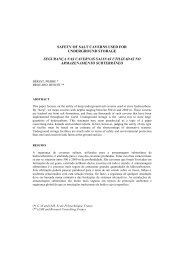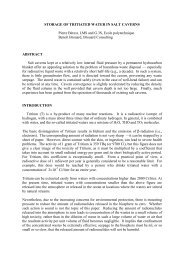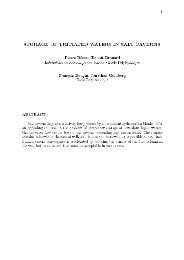1. introduction 2. cavern thermal status - Brouard Consulting
1. introduction 2. cavern thermal status - Brouard Consulting
1. introduction 2. cavern thermal status - Brouard Consulting
You also want an ePaper? Increase the reach of your titles
YUMPU automatically turns print PDFs into web optimized ePapers that Google loves.
For a cylindrical <strong>cavern</strong> with height H and diameter D, the following formula can be used:32/3 2c(years) 4.67 (m ) /100,000exp 0.91 <strong>1.</strong>972 ,t V Ln A where Ln is the Neperianlogarithm, and A H Dis the <strong>cavern</strong> aspect ratio (see Karimi-Jafari et al., 2007).Figure 5. A hypothetical, average, 1300-m-deep <strong>cavern</strong>. Its volume is V = 300,000 m 3 . The gapbetween the rock geo<strong>thermal</strong> temperature and the brine temperature is ΔT = 30 °C. If nowaiting period is observed, hydro-fracturing will take place. (The <strong>cavern</strong> pressure will be higherthan the geostatic pressure.) The <strong>thermal</strong> characteristic time is tc 7 years. A waiting period of8.3 years (before sealing the <strong>cavern</strong>) allows for a significant decrease in brine temperature.Note that the waiting time is longer when <strong>cavern</strong> volume is larger. For this reason, the abandonment oflarge <strong>cavern</strong>s raises a difficult problem when the initial temperature gap (between rock mass and<strong>cavern</strong> brine) is not small, as the brine-warming rate is slow. (Note, also, that when measuringtemperature evolution in a very large <strong>cavern</strong>, gauges must be accurate, as the rate of temperatureincrease is exceedingly slow.)
Figure 7. Leak detection system. The annular space is filled with a light liquid hydrocarbon. Q ais the hydrocarbon leak rate and Q b is the brine permeation rate. When thehydrocarbon leak rate is zero, the “annular pressure vs. time” and the “centraltubing pressure vs. time” curves are exactly parallel, as no change in interfacelocation takes place. When hydrocarbon seeps to the rock formation, the interfacerises, and the two curves are not parallel. Note that the <strong>cavern</strong> neck must beconsistent and sufficiently high to be able to perform such a test.Figure 8. This test is described on Figure 10. The difference between the tubing pressure and theannular space pressure, as measured at the wellhead, remains almost perfectly constant — clearproof that there is no leak through the casing or casing shoe. Tiny fluctuations of both pressurescan be observed; they can be attributed to atmospheric pressure variations and earth tides.
This “leak detection system” proved to be extremely effective, but it cannot be used when the <strong>cavern</strong>neck is not high enough. (With regard to leaks, when there is no <strong>cavern</strong> neck, the interface rapidlyrises above the casing seat, and leaks through the casing shoe no longer can be detected).6.<strong>2.</strong>2 Trial-and-error abandonment testIn the trial-and-error abandonment test, instead of a single phase, several phases are managed (Fig. 9).At the beginning of each phase, a specific initial pressure value is imposed through liquid (brine orliquid hydrocarbon) injection or withdrawal. When the pressure consistently increases (respectively,decreases) for a sufficiently long period of time, it can be inferred that <strong>cavern</strong> pressure is lower(respectively, higher) than the equilibrium pressure. In such a case, a higher (respectively, lower)initial pressure is tried at the beginning of the next phase.One significant advantage of this method is that, when transient effects and brine warming can beneglected, it provides both lower and upper bounds for the equilibrium pressure.The temperature gap was tentatively defined in Section <strong>2.</strong> A more precise definition can be proposednow: the temperature gap can be considered as small if the brine pressure increase due to brine <strong>thermal</strong>expansion, or PthT/ ,is smaller than the difference between the geostatic pressure and theequilibrium pressure at casing seat depth, Pth PPeq. Note that when long-term safety isconsidered, the <strong>cavern</strong> brine pressure must be smaller than the geostatic pressure at <strong>cavern</strong>-roof depth— not at <strong>cavern</strong> mid-depth, as was explained by Wallner and Paar (1997).Figure 9. Cavern closure rate is a decreasing function of <strong>cavern</strong> pressure: it vanishes to zerowhen <strong>cavern</strong> pressure = geostatic pressure. Brine permeation + leak flow-rate is anincreasing function of <strong>cavern</strong> pressure. When the two curves cross (left), theequilibrium pressure is reached. The trial-and-error method consists of successivelytesting several <strong>cavern</strong> pressure to obtain lower and upper bounds for theequilibrium pressure.
Figure 10. EZ53 <strong>cavern</strong>, operated by GDF Suez at Etrez, Ain, France (see Figure 1). This testwas supported by the SMRI. The <strong>cavern</strong>’s halmostatic pressure is P h = 1<strong>1.</strong>2 MPa, with geostaticpressure of P =20.5 MPa. Four phases were managed. When the test started, a <strong>cavern</strong> pressureof P = 14.1 MPa was tried. Pressure consistently decreased, and, after some time, a lowerpressure was tested. “Jumps” in the pressure-vs-time curve are due to electronic instabilities.Note that a leak appeared on day 293 (pressure decreased over a couple of weeks, although<strong>cavern</strong> pressure was below equilibrium pressure); it was detected by the leak detection systemand repaired on day 315. From this test, the equilibrium pressure can be inferred to be:P =13.0 0.1 MPa.eq
Figure 1<strong>1.</strong> SPR3 <strong>cavern</strong>, operated by Total at Carresse, France. This <strong>cavern</strong> is 700-m deep and3its volume is V 10 11,000 m ; it has a halmostatic pressure is P h = 8.2 MPa. Various pressureswere tested successively. The equilibrium pressure seems to be in the range P eq = 9.5 to 10.5 MPa(9.5 to 10 bars). However, during this test, the duration of the various phases was too short, anda definite conclusion difficult to draw. Note that a brine outflow test (see Section 7.1), wasperformed during the IJ phase.7. AN UPPER BOUND FOR LONG‐TERM PERMEATION AND LEAK RATESIt is interesting to obtain directly an upper bound for the rate of maximum brine flow that can seep tothe overburden layers after the <strong>cavern</strong> has been sealed and abandoned. A simple method can be usedwhen <strong>cavern</strong> brine is cooler than the rock geo<strong>thermal</strong> temperature at <strong>cavern</strong> depth and when the <strong>cavern</strong>has been kept idle during a long period of time with little or no pressure was applied at the wellhead.The test consists of opening the wellhead and measuring the brine outflow rate. In the long term, when<strong>thermal</strong> equilibrium is reached, the flow rate of brine expelled from the <strong>cavern</strong> to the rock massexactly equals the <strong>cavern</strong> closure rate. The driving force for the creep-closure rate is the differencebetween geostatic pressure and <strong>cavern</strong> brine pressure. This driving force is largest when the <strong>cavern</strong> isopened and brine pressure is halmostatic. A brine outflow test provides an upper bound for the longtermrate of expelled brine. This method works well when the rate of increase in brine temperature iszero, or when it can be assessed accurately and its effects taken into account.7.1 Brine outflow testBrine outflow test are more difficult to perform than shut-in tests: brine flow must be collected in acontainer, and the volume of brine in the container must be measured as often as possible. Figure 12present the results of two brine outflow tests. In a large and shallow <strong>cavern</strong>, the effects of atmosphericpressure variations are dramatic during a brine outflow test, and the brine outflow rate is somewhat
erratic when short periods of time (a couple of days) are considered. In fact, the brine-outflow ratemust be averaged over a long period of time to provide reliable results.(a)Figure 1<strong>2.</strong> Brine outflow tests on (a) the SPR3 <strong>cavern</strong> (depth: 700 m, volume: 11 000 m 3 )operated by Total and (b) the EZ53 <strong>cavern</strong> (depth: 950 m, volume: 8 000 m 3 )operated by GDF Suez. Thermal equilibrium was reached in these two <strong>cavern</strong>s.From these tests, it can be inferred that an upper bound for brine seepage when the<strong>cavern</strong>s are sealed and abandoned is 2<strong>2.</strong>6 liters/day and 7.2 liters/day (8 m 3 /yr and 3m 3 /yr), respectively. Much faster brine outflow must be expected in larger or deeper<strong>cavern</strong>s.(b)7.2 Shut‐in testAn example of a shut-in test is given on Figure 13. At the beginning of this 6-month-long test, the<strong>cavern</strong> was shut in. (The absolute wellhead pressure is represented in the figure). The rate of pressureincrease was P/ t = 0.01471 kPa/day —a very low figure, as this <strong>cavern</strong> is shallow (H = 250 m)and the <strong>cavern</strong>-closure rate is exceedingly slow. Cavern compressibility is V130 kPa/liter, and theupperupper bound for the long-term brine outflow rate is Q 6 liters/day or 2 m 3 /yr. This examplehighlights the significance of <strong>thermal</strong> equilibrium. A brine-temperature increase rate ofTt 0.02 °C/yr (definitely a slow temperature-increase rate!) would generate a pressure increaserate of P/ t ( / ) T / t20 kPa/yr 0.055 kPa/day — i.e., a pressure increase rate fasterthan the pressure increase rate observed during this test.A simpler but slightly less direct method consists of shutting the well and measuring the pressurebuild-up rate over a couple of weeks. Let P tbe the pressure build-up rate (for instance, inMPa/day). An upper bound for brine outflow rate (in m 3 /day) when the <strong>cavern</strong> is sealed andupper3abandoned is Q V P t,where V(in m MPa) is the <strong>cavern</strong> compressibility (as explainedin Section 2).
Figure 13. Example of a 6-month-long shut-in test.8. A COMPREHENSIVE ABANDONMENT TESTWhen the temperature gap is assessed correctly, when the duration of each phase is long enough, andwhen, in addition, a leak-detection system is set in the <strong>cavern</strong>, as explained in Sections 6 and 7, the“abandonment test” performed according to the trial-and-error method can be considered the best testto be performed. Strictly speaking, no further data or tests are required. However, the abandonmenttest is more convincing still when pressure evolution can be predicted before the test and/or whenphysical parameters can be back-calculated accurately after the test.A complete discussion of this issue is beyond the scope of this paper. Examples will be providedduring the afternoon session. The objective of this section is to highlight the main parameters requiredto be able to perform numerical computations.8.1 Temperature evolution computationTogether with the <strong>cavern</strong> shape and the results of in situ temperature measurements (Section 1), threeparameters are needed: (1) rock <strong>thermal</strong> conductivity, or K ; (2) rock <strong>thermal</strong> diffusivity, or k;and (3)the brine <strong>thermal</strong>-expansion coefficient, or [Note that rock <strong>thermal</strong>-expansion coefficient plays aminor role, as temperature changes in the <strong>cavern</strong> only generate tiny changes <strong>cavern</strong> volume, (Karimi-Jafari et al., 2007)]. These parameters are site-specific, although the following figures can provide, at6 2 24least, a first approximation: K 6 W/m/°C, k 310 m /s (or 100 m / yr); 4.4 10 / °C. Theequations that describe temperature evolution are provided in Van Sambeek et al. (2005) The difficultpoint is with the initial temperature conditions as, in most cases, a <strong>cavern</strong> experiences manytemperature changes during operation (for instance, when fluids are injected/withdrawn from the
<strong>cavern</strong>). However one considerable asset of <strong>thermal</strong> evolution lays in the fact that it is not stronglycoupled with mechanical and hydraulic phenomena. (Thermal evolution can be computedindependently.)8.2 Computation of mechanical evolutionTo determine the equilibrium pressure, we must know the steady-state <strong>cavern</strong> closure rate as afunction of <strong>cavern</strong> pressure. As seen in Figure 14, the corresponding curve is non-linear. The closurerate is zero when <strong>cavern</strong> pressure is geostatic. Laboratory tests and numerical computations allow us tondraw this steady-state curve. The Norton-Hoff law often is accepted: A exp ( Q/ RT) , wheren, Q/R and A are three site-specific constants. However, it must be kept in mind that when a fullprediction of the test is required (not only a prediction of the equilibrium pressure value), a descriptionof the transient mechanical behavior of salt also is needed.Figure 14. Steady-state <strong>cavern</strong> closure rate as a function of <strong>cavern</strong> pressureNote that when the effects of brine <strong>thermal</strong> expansion can be neglected or can be computed precisely,a brine outflow test allows (determination of one point of the curve (the point at which the curvecrosses the halmostatic pressure line).8.3 Computation of permeation and leaksLeaks through the casing and casing shoe are a well-specific phenomena. They can be determined onlywhen a leak-detection system is used. A tentative prediction of brine permeation rate can be madewhen permeability tests are performed in the laboratory. Rock-salt permeability is in the rangehyd 22 18 2K 10 10 m , but the hydraulic diffusivity of rock is more difficult to assess. However,laboratory tests performed on rock samples often underestimate the permeability of the rock mass. Forthis reason, it is better to perform in situ permeability tests in a drill hole before leaching starts.Examples of this are described in Durup (1990) and <strong>Brouard</strong> and Bérest (2001).Most authors [see, for example, Fokker (1995)] agree that, at the <strong>cavern</strong> wall, salt experiences adramatic increase in permeability when <strong>cavern</strong> pressure is close to geostatic (or, more precisely, whenbrine pressure is close to the least compressive main stress, which can be lower than the geostatic
pressure when <strong>cavern</strong> pressure has remained low during a long period of time). For this reason, thebrine flow rate vs. <strong>cavern</strong> pressure curve is linear only when small <strong>cavern</strong> pressures are considered.However, several authors believe that rock salt is (almost) perfectly impermeable in its virgin state.According to these authors, salt permeability is secondary — i.e., generated by stress changes in thevicinity of the <strong>cavern</strong> walls.In principle, the steady-state brine-outflow rate as a function of <strong>cavern</strong> pressure can be computed whensalt permeability is known: it is zero when <strong>cavern</strong> pressure equals brine pore pressure. It often isassumed that brine pore pressure equals halmostatic pressure (No brine seepage occurs takes placewhen the wellhead is opened.), but this assumption is difficult to substantiate.Here, again, it must be kept in mind that when an accurate prediction of the test (not only a predictionof the value of the equilibrium pressure) is required, a description of the hydraulic transient behavioralso is needed.Figure 15. Steady-state brine seepage+permeation rate as a function of <strong>cavern</strong> pressure8.4 Determination of the equilibrium pressureWhen the two above-mentioned curves are drawn, the equilibrium pressure can be computed. Whendesigning a trial-and-error test, it is better to select a test pressure not too different from the (predicted)equilibrium pressure (see Figure 16).Figure 16. Definition of the equilibrium pressure.
8.5 Computation of pressure evolution during an abandonment testWhen rock <strong>thermal</strong> properties, rock mechanical properties, rock hydraulical properties and <strong>cavern</strong>compressibility are known, pressure evolution during an abandonment test can be computed. Note thatthis problem is fully coupled. (Except for brine-temperature evolution, each of these three phenomenais influenced by the other two.) Transient phenomena (additional dissolution, transient creep, transientpermeation, etc.) must be taken into account, and dedicated software is needed. Details can be found inthe presentation by Benoît <strong>Brouard</strong>.Figure 17. Trial-and-error test: The influence of transient phenomena is illustrated — after arapid pressure change, pressure evolution is transient.8.6 Back‐analysisIn most cases, accurate, “blind” prediction of pressure evolution is difficult: if some parameters arerelatively well known (<strong>cavern</strong> compressibility, rock steady-state mechanical behavior, etc.), the valuesof other parameters (for example, rock permeability and history of <strong>cavern</strong> temperature before the test)often are affected by a large uncertainty. However, an inverse problem can be solved by performingdifferent computations; in each computation, reasonable values of the main parameters are used.Computation results are compared with selected parts of the as-measured <strong>cavern</strong>-pressure evolutioncurve, and a best-fit (which provides a best-estimate of the parameters) is sought. This process can bemade automatic, and hundreds of computations can be performed, allowing fast convergence towardthe optimal solution. (Examples are provided during the afternoon session). Figure 18 presents anexample of the optimization procedure.
Figure 18 - Example of an optimization procedure. The abandonment test was performed on aCarresse <strong>cavern</strong>. Permeability is fixed ( Kperm20 24 10 m ), and the best * , A n pair of parameters ofthe Norton-Hoff law is searched for. No clear optimum is found, as the range of variation of <strong>cavern</strong>pressure is small, but suitable A * , n pairs can be identified.REFERENCES<strong>Brouard</strong> B., Karimi-Jafari M., Bérest P., Durup G. (2007). Pressure build-up in a sealed <strong>cavern</strong>: effectof a gas blanket. Proc. SMRI Spring Meeting, Basel, Switzerland, p.179-190.<strong>Brouard</strong> B., Bérest P., Durup G. (2001). In-situ Salt Permeability Tests. Proc. SMRI Fall Meeting,Albuquerque, New Mexico, p.139-157.Crotogino F., Kepplinger J. (2006) Cavern Well Abandonment Techniques Guidelines Manual. Report2006-3 for the SMRI.Diamond H.W., Bertram B.M., French P.S., Petrick G.D., Schumacher M.J.,Smith J.B. (1993).Detecting very small casing leaks using the water-brine interface method. Proc. Seventh Symp. Salt,Vol. I. Amsterdam: Elsevier Science Publishers B.V., p.363-368.Durup G. (1990). Field Tests in Well EZ 58. SMRI Project Report n°90-00002-S.Fokker P.A. (1995). The behavior of salt and salt <strong>cavern</strong>s. PhD thesis, Delft University of Technology,The Netherlands.Jafari-Karimi M., Bérest P., <strong>Brouard</strong> B. (2007). Thermal Effects in Salt Caverns. Proc. SMRI SpringMeeting, Basel, Switzerland, p.165-177.Van Sambeek L.L., Bérest P., <strong>Brouard</strong> B. (2005). Improvements in Mechanical Integrity Tests forsolution-mined <strong>cavern</strong>s used for mineral production or liquid-product storage. SMRI Research ProjectReport 2005-<strong>1.</strong>Wallner M. & Paar W.A. (1997). Risk of progressive pressure build up in a sealed cavity. Proc. SMRIFall Meeting, El Paso, Texas, p.177-188.
















